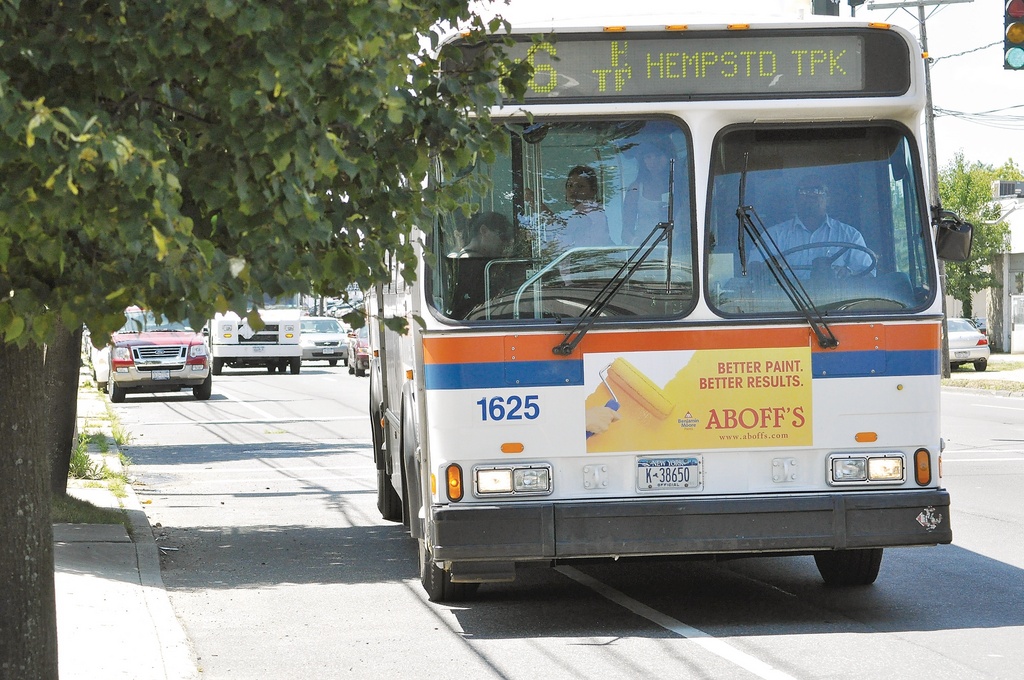MTA may cut LI Bus funding
Long Islanders, get some boots that are made for walking.
The Metropolitan Transportation Authority is considering pulling all funding from Long Island Bus, a move that could wipe out Nassau County’s public bus system. The news comes as the agency reviews money-saving proposals for next year’s budget.
“As we prepare to release our preliminary financial plan ... we’re working closely with Nassau County to find a sustainable funding solution for Long Island Bus,” said MTA spokesman Aaron Donovan in a statement last week. “The county, which owns the buses and depots, is responsible for providing funding to cover the LI Bus operating deficit. The MTA has assumed more and more of this responsibility over the past decade, but we can no longer afford to assume the county’s responsibility.”
The MTA contributes some $40 million to LI Bus’ $133 million budget, while the county, which owns the 47-line system, pays $9.1 million and the state pays $44 million. Fare-paying customers make up the difference. But the MTA, facing an $800 million deficit, wants to stop subsidizing LI Bus altogether and have the county pick up the tab.
Nassau County Executive Ed Mangano has a plan of his own. In a statement also released last week, he announced the formation of a committee to explore privatizing the public bus service.
“It’s just outrageous that the MTA would consider eliminating this funding and stranding about 100,000 riders without any way to get to work, college or to see a doctor,” Mangano said. “The taxpayers of Nassau County can no longer be shaken down by the MTA, whose only concern is funding their bloated bureaucracy. I am offended by the MTA’s threats and pure arrogance, and for that reason we will begin to explore the privatization of LI Bus as several cities and states have begun to do.”
In June, the MTA cut 11 LI Bus lines and reduced service on eight others. It also slashed its Able-Ride service, which serves people with disabilities, and eliminated some trains on the Long Island Rail Road, including weekend service on the West Hempstead branch. Yet the MTA continued to hire high-level employees, according to Mangano and published reports, which noted that the agency is poised to spend more than $1 million to hire 11 additional managers and executives. The MTA reportedly spends $4.2 billion on salaries every year — nearly 40 percent of its budget.
Additionally, Mangano pointed out, the county has been paying the MTA some $3 million annually in payroll taxes. “After placing a job-killing tax on employers, we now learn they plan to cut critical bus service for employees to get to work,” he said. “It’s no wonder we have the most uncompetitive business environment in the nation.”
Rumor has it that the MTA and Nassau County are discussing a compromise whereby the agency would continue to temporarily subsidize Long Island Bus if the county commits to gradually increasing its financial support until it covers the MTA’s entire $40 million. Neither the MTA nor Mangano would verify that possibility.
Initial reports suggested that the county may look to the state for more funding, but that may not be a realistic option. Still without a 2010-11 budget and facing deficits of its own, the state is unlikely to agree to contribute more funding for Nassau’s bus system. The state already provides more transportation aid to Nassau than to neighboring counties, including Suffolk, which gets about $22.5 million and no MTA funding.
“With Nassau residents already paying $182 million more a year in new MTA-related taxes and fares, eliminating Long Island Bus service entirely would unfairly target Long Islanders who already pay more than their fair share,” said state Sen. Dean Skelos (R-Rockville Centre). “I urge the MTA and Nassau County to resolve this issue, so riders can continue to depend on the services of Long Island Bus..”
One way or another, fares keep going up
Among the MTA’s money-saving proposals is the extension of peak travel times on the Long Island Rail Road.
The agency expects to generate more revenue by implementing a general fare hike, extending the LIRR’s peak hours, which haven’t been altered in 15 years, and charging peak fares to “reverse commuters” who travel eastbound in the mornings and westbound in the evenings. The MTA plans to raise overall fare revenue by 7.5 percent in 2011.
Those who ride the LIRR during peak, or rush-hour, times can pay up to 44 percent more for a ticket than those who ride during off-peak hours.
According to published reports, some 22.5 million of the LIRR’s annual 83 million customers travel during off-peak hours, though fewer than 3 percent of its daily riders are reverse commuters.
The MTA declined to comment on the proposal, saying that details of proposed fare hikes would be made public this week. Public hearings would be held before any increases take effect.
Comments about this story? LLandor@liherald.com or (516) 569-4000 ext. 205.

 50.0°,
Mostly Cloudy
50.0°,
Mostly Cloudy 




